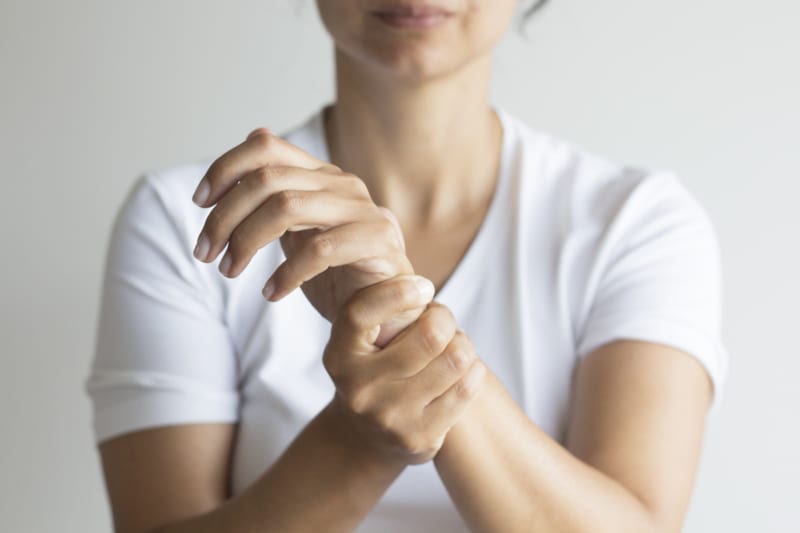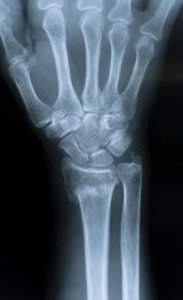Understanding and Preventing Common Snow Sport Wrist Injuries
There are more than 250 million ski and snowboard enthusiasts worldwide, and as people eagerly hit the slopes, the exhilarating rush of snow sports comes with its fair share of potential risks, particularly for the wrists. The nature of activities like skiing and snowboarding involves balancing, quick turns, and sometimes unexpected falls, putting the wrists at a significant risk of impact.
In this blog, we’ll explore some of the most common snow sport wrist injuries and discuss strategies to prevent and manage them, ensuring a safer and more enjoyable winter adventure.
What are the 3 wrist injuries you’ll likely suffer?
Wrist and hand injuries are very common when skiing, in particular with beginner and novice skiers and snowboarders.
Snowboarder’s Wrist
One of the most prevalent wrist injuries in snowboarding is the “snowboarder’s fracture.” This refers to a break in the scaphoid bone, often caused by the instinctive reaction to break a fall with an outstretched hand. These will need to be reviewed by a medical professional as fractures can result in longstanding pain and loss of movement, and will be particularly troublesome if they occur in your dominant hand. Scaphoid fractures can take quite a long time to heal due to the location of the bone and the limited blood supply to the area. As you recover, you will need to have an x-ray to ensure that the bone is healing properly. In some cases they will require surgery to stabilise the bone and ensure optimal healing.
Skier’s Thumb
Skier’s thumb is a common injury among skiers and occurs when the thumb is forcefully bent backward, causing damage to the ligaments. The ligament that is usually damaged is the ulnar collateral ligament (UCL) of the thumb. The UCL helps stabilise the thumb and is crucial for gripping and pinching.
This can happen during a fall while still gripping a ski pole. It is vital that you seek medical attention immediately if you have injured your thumb and it becomes painful or swollen after a fall.
It is very important to get an accurate diagnosis, so that your treatment can be targeted and personalised, ensuring optimal treatment outcomes.
Ultrasound imaging is a valuable diagnostic tool for assessing skier’s thumb. Ultrasound uses high-frequency sound waves to create real-time images of the soft tissues, providing detailed views of the ligaments, tendons, and other structures in the thumb joint.
Wrist Sprains
Quick turns, unexpected bumps, and icy patches on the slopes can lead to falls, resulting in wrist sprains. A wrist sprain is an injury that occurs when the ligaments, which are tough bands of fibrous tissue connecting bones to each other, are overstretched or torn.
Distal Radius Fractures
High-impact falls or collisions can lead to distal radius fractures.
A distal radius fracture refers to a break or crack in the larger of the two forearm bones, (the radius), near the wrist joint. They can vary in severity, from simple hairline fractures to more complex breaks that may involve displacement of the bone. Proper medical assessment and timely intervention are essential to promote optimal healing and restore functionality to the wrist.
TFCC Tears
A triangular fibrocartilage complex (TFCC) tear refers to an injury involving the cartilage and ligaments located on the ulnar side of the wrist, providing stability to the joint. Injuries to this area are not uncommon in snow sports. Falls onto an outstretched hand or repetitive stress can cause TFCC tears.
What Should I Do If I Have Sustained an Injury?
It is vital that you get a rapid and accurate diagnosis of your injury in order to make sure that you receive the best and most appropriate treatment.
Complete Physio have highly specialised clinicians who are skilled diagnosticians, and will carry out an in depth and thorough assessment. Our physiotherapists can also refer you for an MRI scan if required.
Click on the link to make an appointment or simply call 0207 482 3875 or email info@complete-physio.co.uk
What Can I Do to Prevent Getting Injured?
Protective Gear
Invest in quality wrist guards or gloves with built-in wrist protection, especially if you’re a snowboarder. These guards will give you better support and absorb impact during falls, which will reduce the risk of fractures and sprains.
Pre-Season Conditioning Exercises
Making sure that you are fit and strong before you get out on the mountain will make you much less likely to suffer from an injury. It’s worth seeking advice from a Physiotherapist or strength and conditioning coach, who can provide you with a programme that not only targets the wrists and forearms, but will also ensure you have excellent balance and whole body strength and fitness.
Proper Technique
If you are a beginner or novice skier or snowboarder, then enrol in lessons or work with a certified instructor to work on your technique. Often you will also be taught how to fall safely to minimise the impact on your wrists.
Warm-Up and Stretching
Prior to hitting the slopes in the morning, make sure that you do a thorough warm-up routine to prepare your muscles and joints for the physical demands of snow sports. Include wrist-specific stretches to improve flexibility and reduce the risk of strains.
Here’s a list of stretches to consider incorporating into your pre-skiing routine:
Quad Stretch: Stand on one leg and bring your other foot towards your buttocks, holding the ankle with your hand. Keep your knees close together, and hold the stretch for 15-30 seconds. Repeat on the other leg.
Hamstring Stretch: Sit on the ground with one leg extended straight and the other foot against the inner thigh of the extended leg. Reach toward your toes, keeping your back straight. Hold for 15-30 seconds and switch legs.
Hip Flexor Stretch: Kneel on one knee with the other foot in front, forming a 90-degree angle. Lean forward slightly, feeling the stretch in the hip of the leg with the knee on the ground. Hold for 15-30 seconds and switch sides.
Calf Stretch: Stand facing a wall with your hands pressed against it. Step one foot back, keeping it straight, and press the heel into the floor. Hold for 15-30 seconds and switch legs.
Dynamic Leg Swings: Holding onto a support, swing one leg forward and backward in a controlled manner. Then, swing it side to side. Repeat with the other leg. This helps improve flexibility and increases blood flow.
Torso Twists: Stand with your feet shoulder-width apart, and gently twist your torso from side to side. This helps to warm up your spine and core muscles.
Side Bends: Stand with your feet shoulder-width apart and arms raised overhead. Gently lean to one side, holding the stretch for 15-30 seconds, and then switch to the other side.
Shoulder Rolls: Roll your shoulders backward in a circular motion for about 15 seconds, and then switch to forward rolls. This helps to loosen up your shoulder muscles.
Neck Stretch: Gently tilt your head to one side, bringing your ear towards your shoulder until you feel a stretch on the opposite side of your neck. Hold for 15-30 seconds, and then switch sides.
Remember to perform these stretches in a controlled and gentle manner, avoiding any sudden or jerky movements. Tailor the duration of each stretch to your comfort level and individual needs. Additionally, consider your specific skiing activities and focus on areas that may be more prone to strain during your day on the slopes.
Mindful Riding
Stay alert and be mindful of your surroundings when you’re on the mountain. Slopes can get very busy during school holidays, so recognising and staying clear of potential hazards on the slopes can help you navigate them safely and reduce the likelihood of sudden falls or collisions.
Immediate First Aid and Medical Advice
If you experience a fall or suspect a wrist injury, it’s crucial to seek professional medical help for a comprehensive diagnosis. Very often you might just need a day to rest and recover, however if it is something more serious, you may need to have some scans or x-rays.
Whether you’re a seasoned rider or a novice, enjoying the winter wonderland on skis or a snowboard is an invigorating experience, but safety should always be a priority!
Complete Physiotherapy Treatment for Wrist injuries
At Complete Physio we see a huge influx of snow sport injuries throughout the winter season. Our team of Physiotherapists are exceptionally skilled at diagnosing and treating wrist injuries. Whether it’s a sprain, fracture, or ligament tear, the specialised care provided by our physiotherapists is crucial for promoting optimal healing and restoring functional movement.
Many soft wrist tissue injuries and fractures can easily be diagnosed using diagnostic ultrasound. Complete Physio offers a unique one stop shop – we have a number of specialists who are dual trained sonographers, who will carry out an ultrasound scan as part of their clinical assessment. You do not need a GP referral, and we do not charge extra for an ultrasound scan.
To book an appointment to see one of our clinical specialists, please call 020 7482 3875 or email info@complete-physio.co.uk. Please ensure you inform our administration team at the time of booking if you would like to book an appointment including an ultrasound scan.
Physiotherapy interventions often include targeted exercises to strengthen the muscles around the injured wrist, enhance flexibility, and improve joint stability. We ensure that we work closely with our patients to develop a personalised rehabilitation plan, guiding you through progressive exercises that address the specific challenges posed by skiing-related wrist injuries.
This holistic approach not only facilitates a quicker recovery but also aims to prevent the recurrence of injuries, allowing you to return to the slopes with confidence and a reduced risk of future wrist issues.
If your injury is more complex, or your recovery is not going to plan, we work very closely with some of the best hand and wrist specialists and surgeons in the country, and we will be able to directly refer you to the most appropriate one for you.
Our 5 Top Tips if you get injured
If you do get injured when you’re out on the slopes, here are some useful tips:
- Most soft tissue injuries and some breaks do not need an immediate operation. It is often best to wait, get safely back to the UK and then start investigating all the options.
- Call your insurance – inform them of the situation. Don’t delay or you may not be covered.
- If you have an X-rays, scan or other tests done whilst you are away – get a copy of the results. For example, if you have an X-ray, take a photo of it on your phone. The more information you get the better.
- Seek specialist Input – unless it is a medical emergency you don’t want a hip surgeon operating on your shoulder or a knee surgeon operating on your wrist! Get a hand and wrist specialist to assess your injury.
- Email one of our clinic directors at info@complete-physio.co.uk – we work with a number of world leading clinicians and surgeons and will be able to directly refer you to someone we trust.
We hope you have found this blog helpful. We have a number of other skiing injury blogs which you can find on our blogs page.
Don’t let pain hold you back, book now!






